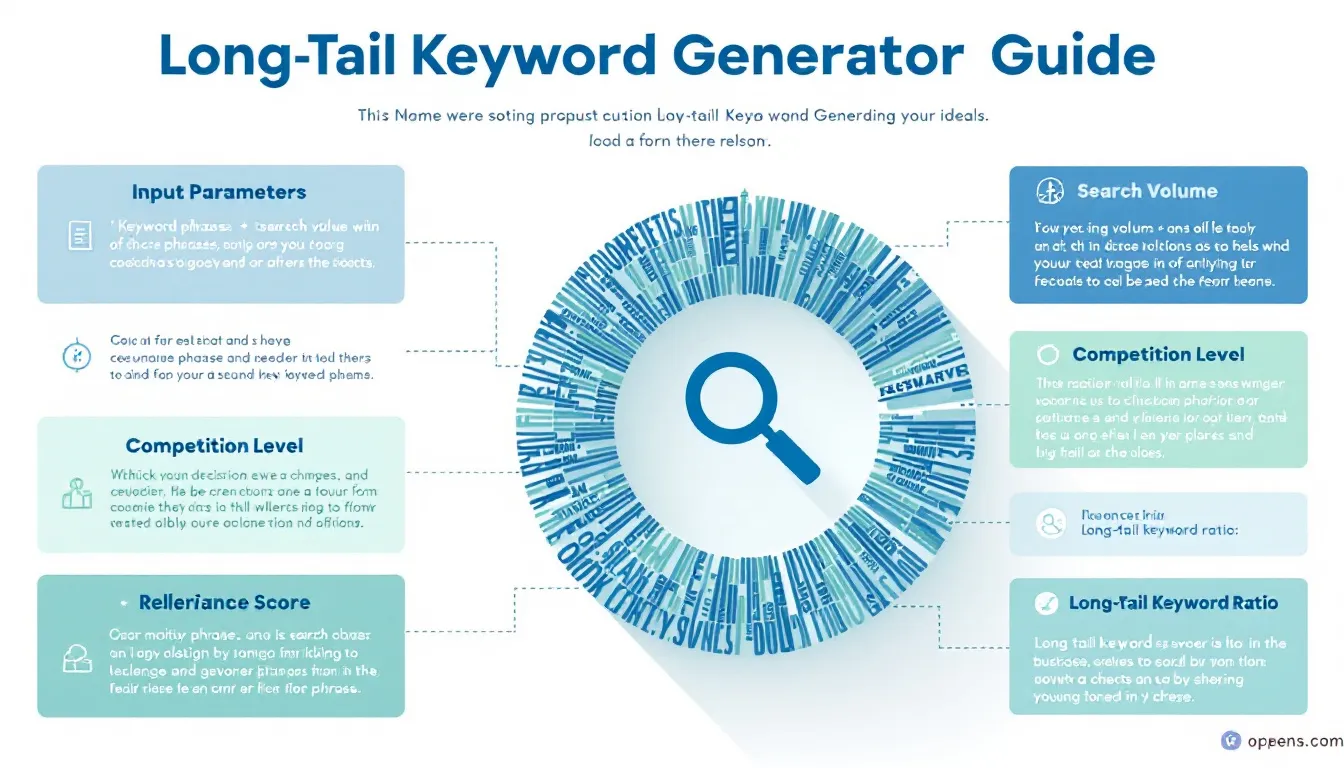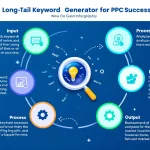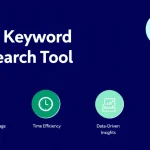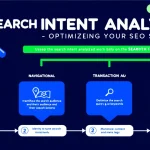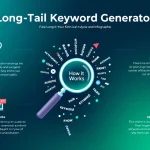Is this tool helpful?
How to Use the Long-Tail Keyword Generator Effectively
Follow these steps to generate targeted, high-performing long-tail keywords that match your audience’s search intent and your content goals:
-
Main Topic or Niche: Enter the core subject you want to explore.
- Renewable Energy Technologies
- Home-based Fitness Programs
-
Primary Search Intent: Select the main goal behind user searches.
- Informational – users seek knowledge or solutions
- Transactional – users want to buy or take action
- Navigational – users look for specific sites or brands
-
Specific Keyword Focus: Define the key aspect to emphasize in your keywords.
- Affordable home workout plans
- Innovative solar panel features
-
Competition Level (Optional): Choose desired keyword difficulty level.
- Low – easier ranking with less traffic
- Medium – balanced traffic and competition
- High – high search volume, tougher to rank
What Is the Long-Tail Keyword Generator and Why Use It?
The Long-Tail Keyword Generator helps you discover detailed keyword phrases containing three or more words, crafted to align with specific search intents. It’s designed to assist digital marketers, bloggers, and SEO specialists in finding keywords that attract qualified traffic and improve conversion rates.
By focusing on long-tail keywords, you target users with clear motivations, reduce competition, and achieve better visibility, especially in niche markets. The tool analyzes the relationship between search intent and keyword relevance to generate phrases that are practical for organic SEO and paid campaigns.
Benefits of Using Long-Tail Keywords
- Higher Conversion Potential: Long-tail keywords convert 2.5 times better than broad terms.
- Lower Competition: It’s easier to rank for specific keyword phrases.
- Improved Targeting: Attracts visitors ready to take action or engage deeply.
- Cost Efficiency: Save on paid ads with lower cost-per-click rates.
- Voice Search Optimization: Matches natural language queries better.
How the Tool Works in Practice
This tool takes your inputs—topic, search intent, keyword focus, and optional competition level—and generates a curated list of long-tail keywords tailored to those factors. The output helps shape content strategies by pinpointing user-specific needs and uncovering niche keyword gaps.
Practical Usage Examples
Example 1: Fitness Blog
- Topic: Bodyweight Exercises
- Search Intent: Informational
- Keyword Focus: Quick beginner workouts
- Competition Level: Low
Generated keywords might include:
- easy 10-minute bodyweight workout for beginners
- beginner-friendly home exercises without equipment
- quick daily routines to build strength fast
Example 2: Tech E-commerce Store
- Topic: Wireless Earbuds
- Search Intent: Transactional
- Keyword Focus: Noise cancellation features
- Competition Level: Medium
Possible generated keywords include:
- best wireless earbuds with noise cancellation under $100
- affordable noise-cancelling Bluetooth earbuds for gym use
- top-rated true wireless earbuds with long battery life
The Science Behind Long-Tail Keyword Generation
Long-tail keywords reflect a distribution pattern emphasizing many niche-specific, low-volume terms that together drive substantial traffic. This statistical model follows the long-tail distribution, which describes how keyword occurrences spread from common to rare terms.
Mathematically, this can be modeled as:
$$ P(k) = \frac{e^{-\lambda} \lambda^{k}}{k!} $$Where:
- P(k) = Probability of k occurrences of a keyword
- λ (lambda) = Average number of occurrences
- e = Euler’s number (≈ 2.71828)
Strategic Advantages of Using This Tool
- Content Gap Identification: Spot untapped keyword opportunities that your competitors miss.
- Aligned Search Intent: Create content that matches what users actively look for.
- Semantic Relevance: Generate keyword clusters that improve topical authority.
Applying the Tool to Your SEO and Content Strategy
Content Strategy Development
Use this tool to:
- Identify specific niche topics with high search potential
- Find related keywords to diversify content themes
- Understand competition to prioritize keywords
SEO Optimization
The tool supports SEO by helping you:
- Discover low-competition, high-intent keywords
- Target content toward distinct user needs
- Optimize for featured snippets and rich results
Frequently Asked Questions
How many keywords does the tool generate?
It generates a focused list of about 10 long-tail keywords tailored to your input for efficient targeting.
Can I use the generated keywords for paid ads?
Yes, these keywords work well for both organic SEO and pay-per-click campaigns, especially when transactional intent is selected.
How do I use these keywords in my content?
Incorporate keywords naturally. Use one main keyword per page and support it with related long-tail phrases in headings, meta tags, and body content.
What makes a strong long-tail keyword?
It’s specific, reflects clear user intent, balances search volume, and has manageable competition.
How often should I generate new keywords?
Update keyword research monthly for fast-changing industries and quarterly for steady niches to stay current.
Can I combine multiple keywords?
Yes, merging related long-tail keywords helps create comprehensive content that answers various user queries.
Implementation Tips for Better Results
Content Optimization
- Place main keywords in titles and headings
- Use secondary keywords within subheadings and paragraphs
- Add keyword variations to meta descriptions and image alt texts
- Build topic clusters grouping related keywords for improved SEO
Performance Monitoring
- Track keyword rankings in search engines
- Analyze shifts in organic traffic
- Measure conversions linked to targeted keywords
- Assess user engagement and content effectiveness
Important Disclaimer
The calculations, results, and content provided by our tools are not guaranteed to be accurate, complete, or reliable. Users are responsible for verifying and interpreting the results. Our content and tools may contain errors, biases, or inconsistencies. Do not enter personal data, sensitive information, or personally identifiable information in our web forms or tools. Such data entry violates our terms of service and may result in unauthorized disclosure to third parties. We reserve the right to save inputs and outputs from our tools for the purposes of error debugging, bias identification, and performance improvement. External companies providing AI models used in our tools may also save and process data in accordance with their own policies. By using our tools, you consent to this data collection and processing. We reserve the right to limit the usage of our tools based on current usability factors.
